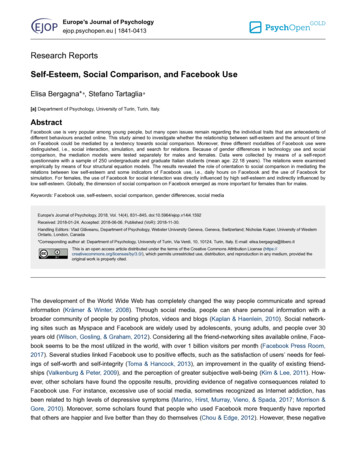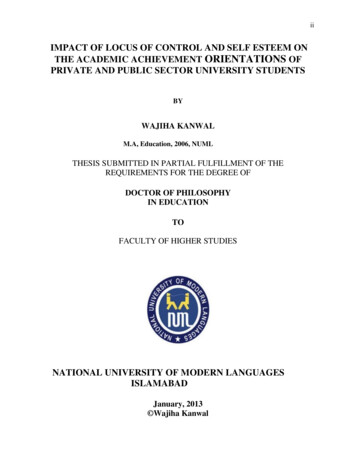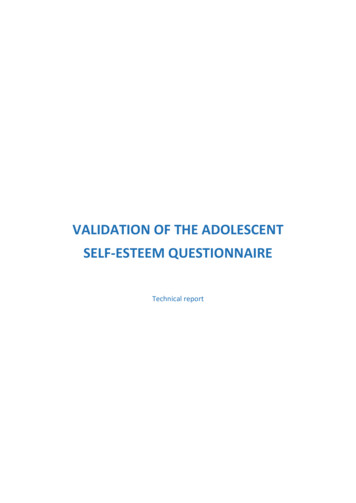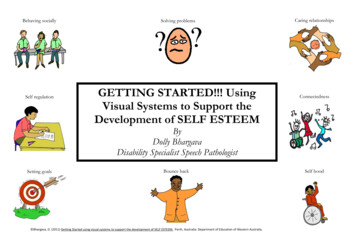
Transcription
Europe's Journal of Psychologyejop.psychopen.eu 1841-0413Research ReportsSelf-Esteem, Social Comparison, and Facebook UseElisa Bergagna* a, Stefano Tartaglia a[a] Department of Psychology, University of Turin, Turin, Italy.AbstractFacebook use is very popular among young people, but many open issues remain regarding the individual traits that are antecedents ofdifferent behaviours enacted online. This study aimed to investigate whether the relationship between self-esteem and the amount of timeon Facebook could be mediated by a tendency towards social comparison. Moreover, three different modalities of Facebook use weredistinguished, i.e., social interaction, simulation, and search for relations. Because of gender differences in technology use and socialcomparison, the mediation models were tested separately for males and females. Data were collected by means of a self-reportquestionnaire with a sample of 250 undergraduate and graduate Italian students (mean age: 22.18 years). The relations were examinedempirically by means of four structural equation models. The results revealed the role of orientation to social comparison in mediating therelations between low self-esteem and some indicators of Facebook use, i.e., daily hours on Facebook and the use of Facebook forsimulation. For females, the use of Facebook for social interaction was directly influenced by high self-esteem and indirectly influenced bylow self-esteem. Globally, the dimension of social comparison on Facebook emerged as more important for females than for males.Keywords: Facebook use, self-esteem, social comparison, gender differences, social mediaEurope's Journal of Psychology, 2018, Vol. 14(4), 831–845, doi:10.5964/ejop.v14i4.1592Received: 2018-01-24. Accepted: 2018-06-06. Published (VoR): 2018-11-30.Handling Editors: Vlad Glăveanu, Department of Psychology, Webster University Geneva, Geneva, Switzerland; Nicholas Kuiper, University of WesternOntario, London, Canada*Corresponding author at: Department of Psychology, University of Turin, Via Verdi, 10, 10124, Turin, Italy. E-mail: elisa.bergagna@libero.itThis is an open access article distributed under the terms of the Creative Commons Attribution License (https://creativecommons.org/licenses/by/3.0/), which permits unrestricted use, distribution, and reproduction in any medium, provided theoriginal work is properly cited.The development of the World Wide Web has completely changed the way people communicate and spreadinformation (Krämer & Winter, 2008). Through social media, people can share personal information with abroader community of people by posting photos, videos and blogs (Kaplan & Haenlein, 2010). Social networking sites such as Myspace and Facebook are widely used by adolescents, young adults, and people over 30years old (Wilson, Gosling, & Graham, 2012). Considering all the friend-networking sites available online, Facebook seems to be the most utilized in the world, with over 1 billion visitors per month (Facebook Press Room,2017). Several studies linked Facebook use to positive effects, such as the satisfaction of users’ needs for feelings of self-worth and self-integrity (Toma & Hancock, 2013), an improvement in the quality of existing friendships (Valkenburg & Peter, 2009), and the perception of greater subjective well-being (Kim & Lee, 2011). However, other scholars have found the opposite results, providing evidence of negative consequences related toFacebook use. For instance, excessive use of social media, sometimes recognized as Internet addiction, hasbeen related to high levels of depressive symptoms (Marino, Hirst, Murray, Vieno, & Spada, 2017; Morrison &Gore, 2010). Moreover, some scholars found that people who used Facebook more frequently have reportedthat others are happier and live better than they do themselves (Chou & Edge, 2012). However, these negative
Self-Esteem and Facebook832psychological outcomes are mainly related to the way people use Facebook rather than to the social networkitself. For most people, this social medium does not have positive or negative consequences, but for other individuals, Facebook use may be a maladaptive way of escaping from problems or relieving a dysphoric mood(Cash, Rae, Steel, & Winkler, 2012). For this reason, it becomes important to investigate individual traits thatcan predict harmful online behaviours so they can be prevented.Facebook and Self-EsteemIn psychology, self-esteem is defined as the positive or negative evaluation of the self, and many theories havesuggested that maintaining or raising it is a basic human need (Weiten, 2004). Regarding the relationship between self-esteem and Facebook use, scholars have found contradictory results. Most studies (Kalpidou,Costin, & Morris, 2011; Mehdizadeh, 2010; Tazghini & Siedlecki, 2013) found that people with lower self-esteem spend more time on Facebook. Some authors have interpreted this finding using social compensationtheory. Social compensation theory, or the poor-get-richer hypothesis, states that people who experience difficulties in social relations, such as individuals with low self-esteem, socially anxious individuals, and introverts,are more motivated to use social networks in order to compensate for their unsatisfactory face-to-face interactions (McKenna, Green, & Gleason, 2002). An opposite perspective is social enhancement, or the rich-get-richer hypothesis. According to this theory, for more sociable young people, there are added benefits from expanding communication through social media: socially active people, with high levels of self-esteem, are more inclined to utilize friend-networking sites as a means to extend their social network further (Kraut et al., 2002).However, few studies have found evidence that people with a positive self-evaluation spend more time onFacebook (Ghosh & Dasgupta, 2015). Instead, other studies found no relation between self-esteem and Facebook use (Skues, Williams, & Wise, 2012). As some scholars have suggested, the literature may be inconsistent because studies have considered Facebook as a whole without distinguishing between different modalitiesof use or motivations to utilize the social network (Rae & Lonborg, 2015; Tartaglia, 2016). Generally, peoplewho communicate easily with others face to face have less need to spend a great deal of time online, but whenconsidering the specific ways Facebook can be used, a different result can be found (Wilson, Fornasier, &White, 2010). A recent study (Tartaglia, 2016) has shown three different modalities of using Facebook, i.e., social interaction, simulation, and search for relations. The first is the use of the social network for interaction withfriends and for self-expression. High self-esteem was found to be a predictor of this modality of using Facebook. In contrast, people who use Facebook to simulate a self-image online that differs from reality had lowself-esteem. Finally, the use of Facebook to seek new relations, i.e., meeting people, was not related to selfesteem.Social ComparisonSocial comparison takes place when individuals compare themselves with others on abilities and personalcharacteristics. Festinger (1954) was the first to theorize that comparing oneself to others is a human need essential for acquiring information about the self. As some authors noted (Gilbert, Price, & Allan, 1995), the needto compare oneself to others is phylogenetically very old and biologically very powerful; however, individualsdiffer greatly in the extent to which they tend to confront each other (Gibbons & Buunk, 1999). Many scholars(Buunk & Gibbons, 2007; Steil & Hay, 1997; Wheeler, 2000) have suggested that certain types of individualsmay be more inclined to compare than others, hypothesizing that the tendency to engage in social comparisonsmay be a personality characteristic. The “typical” individual with a high tendency to engage in social comparison is characterized by certain features, such as an increased sensitivity to the behaviour of others and a deEurope's Journal of Psychology2018, Vol. 14(4), 831–845doi:10.5964/ejop.v14i4.1592
Bergagna & Tartaglia833gree of uncertainty about the self, along with a great need to reduce this uncertainty and improve her/his selfworth (Gibbons & Buunk, 1999). Individuals with low self-esteem, whose self-concepts are inconstant and uncertain, are particularly interested in making social comparisons (Buunk & Gibbons, 2007). This tendency towards social comparison may be facilitated by modern technologies, which have transferred many social relations from the private to the public sphere, exposing people to a continual flow of information (Subrahmanyam& Greenfield, 2008). Specifically, people on Facebook may compare themselves with others on the number oflikes and the types of comments that other people have posted to their statuses and photos; moreover, afriend’s status or photos may trigger specific social comparisons, which can make people feel better or worse(Steers, Wickham, & Acitelli, 2014). Researchers have mainly focused on the consequences of Facebook social comparisons (Feinstein et al., 2013; Krasnova, Wenninger, Widjaja, & Buxmann, 2013; Nesi & Prinstein,2015): their results have shown that social comparison on Facebook may predict depression, rumination andlower life satisfaction. However, some authors (Nesi & Prinstein, 2015) emphasized the hypothesis that depressive symptoms precede and predict social comparisons on Facebook, stating that individuals with low self-esteem who are prone to depression are more likely to spend time on Facebook engaging in higher levels of social comparison. This point of view seems to suggest that a greater tendency towards social comparison mightincrease the use of this social network, motivated by the search for information about others.In summary, social comparison theory suggests that self-esteem influences the tendency to compare oneselfwith others, which in turn would influence the use of Facebook because it may be a tool for social comparison.Although some scholars have suggested this relation (Nesi & Prinstein, 2015), no study to our knowledge hasexamined the role of social comparison orientation in influencing the use of Facebook, neither the overall usenor the specific modalities of use. We aimed to empirically test this theoretical model. Considering the differentmodalities of using Facebook, we can make some specific assumptions. For people whose evaluation of theself is mainly based on the perceived opinions of others (i.e., social comparison), self-expression can become away to reduce uncertainty about the self by eliciting positive feedback from others (Nesi & Prinstein, 2015).Moreover, individuals with a strong social comparison orientation may use Facebook for simulation so that theycan gain benefits from comparisons and increase their self-esteem. These people are worried about image andvery interested in what others think (Buunk & Gibbons, 2007). Finally, the use of Facebook to search for relations should not be related to a social comparison tendency because this modality seems mainly to refer to thesearch for a romantic partner (Tartaglia, 2016).Current ResearchDespite the contradictory results concerning the relationship between self-esteem and Facebook use, most research (Kalpidou et al., 2011; Tazghini & Siedlecki, 2013) has demonstrated that people who spend more timeon Facebook are individuals with lower self-esteem because they need to compensate for their relational faceto-face difficulties. Additionally, individuals with low self-esteem, whose self-concepts are particularly uncertain,are especially interested in social comparison (Buunk & Gibbons, 2007), and this tendency might determinegreater use of Facebook, since this social network makes it especially easy for people to compare themselvesto others (Nesi & Prinstein, 2015). Therefore, we aimed to investigate whether the relationship between selfesteem and the amount of time on Facebook would be mediated by a tendency towards social comparison.Moreover, we wanted to test this mediational model not only on the general use of Facebook but also on threespecific modalities of using Facebook, that is, social interaction, simulation and search for relations (Tartaglia,2016). Finally, we wanted to test the mediation model for males and females separately, since previous re-Europe's Journal of Psychology2018, Vol. 14(4), 831–845doi:10.5964/ejop.v14i4.1592
Self-Esteem and Facebook834search has found gender differences in technology use and social comparison (Nesi & Prinstein, 2015;Stefanone, Lackaff, & Rosen, 2011). Specifically, females seem to share more photos on social networkingsites and spend more time maintaining their social networks than males (Rosen, Stefanone, & Lackaff, 2010).Women are more likely to compare themselves on the dimension of physical attractiveness based on onlinephotos (Haferkamp & Krämer, 2011) and are more susceptible to comparing themselves to others on the dimension of self-expression, which they feel is personally relevant.On these grounds, we expected the following:a. Self-esteem is negatively associated with the amount of time spent on Facebook (Kalpidou et al., 2011;Tazghini & Siedlecki, 2013) and with the use of the social networking site for simulation (Tartaglia, 2016).Self-esteem is positively related to the use of Facebook for social interaction, whereas it is not related tothe use of Facebook to search for relations (Tartaglia, 2016).b. Self-esteem is negatively related to the social comparison orientation (Buunk & Gibbons, 2007).c. Because Facebook is a means for comparing oneself with others (Steers, Wickham, & Acitelli, 2014), socialcomparison orientation is related to time spent on Facebook, the use of Facebook for self-expression (i.e.,the modality of social interaction) and simulation of a different self-image (i.e., the modality of simulation).d. Gender differences in technology use and social comparison (Nesi & Prinstein, 2015; Stefanone et al.,2011) lead to different results in the mediational models tested separately for males and females.MethodParticipantsThe research sample included 250 university students (43.6% male and 56.4% female). The average age ofthe participants was 22.18 years (SD 2.52). A psychology graduate student in collected the data for her master’s degree thesis. Participants attended different courses in the arts and sciences school of a public university.Participation was voluntary.MeasuresWe collected the data using a self-report questionnaire, which took approximately 20 minutes to complete. Thefollowing indicators were used in our analysis:1. The Italian version of the Rosenberg Self-Esteem scale (Prezza, Trombaccia, & Armento, 1997), which iscomposed of 9 items assessing global self-esteem (e.g., “On the whole, I am satisfied with myself”). Itemswere rated on a 4-point Likert-type scale ranging from 1 (strongly disagree) to 4 (strongly agree). The scaleshowed good internal coherence (Cronbach’s α .85).2. The Iowa-Netherlands Comparison Orientation Measure (INCOM; Gibbons & Buunk, 1999), which included11 items measuring participants’ tendency to socially compare themselves to others (e.g., “I always pay alot of attention to how I do things compared with how others do things”). Items were rated on a 5-pointLikert scale ranging from 1 (strongly disagree) to 5 (strongly agree). The scale showed good internalcoherence (Cronbach’s α .90).Europe's Journal of Psychology2018, Vol. 14(4), 831–845doi:10.5964/ejop.v14i4.1592
Bergagna & Tartaglia8353. The amount of time people spent on Facebook, which was assessed through one item asking participants“Approximately how many hours per day do you spend on Facebook?”4. The modality of using Facebook scale (Tartaglia, 2016), including 19 items that presented different activitiespeople can do on Facebook. The instructions for participants read “How often do you do the followingthings on Facebook?” and items were rated on a 4-point Likert-type scale ranging from 1 (never) to 4 (veryoften). The items belong to three subscales measuring different modalities of using Facebook: socialinteraction (e.g., “Comment on other people’s statuses, walls, or links”) consisting of 11 items (α .79);simulation (e.g., “Hide some things about yourself that you don’t like) consisting of 5 items (α .81); andsearch for relations (e.g., “Chat with people you don’t know”) consisting of 3 items (α .72).5. A brief list of socio-demographic items (i.e., gender, age).Data AnalysesAfter performing preliminary analyses, we investigated the hypothesized relationships by testing structuralequation models. We tested the models simultaneously on males and females to investigate gender differences.ResultsPreliminary AnalysesTable 1 shows the mean scores of the measures used in the analyses. We calculated the means separately bygender group and tested the differences using t-tests. Females spent more time daily on Facebook than males.There are no other significant gender differences. Concerning the modality of Facebook usage, social interaction was the most frequent cited by participants. Table 2 shows the correlations among measures. Self-esteemcorrelated negatively with social comparison orientation, daily hours on Facebook, and simulation. Social comparison orientation correlated positively with all the Facebook use indicators. Each Facebook use indicator correlated positively with all the others except for daily hours on Facebook and search for relations, which did notcorrelate.Table 1Scale Scores for Males (n 109) and Females (n 141): Mean scores and t valuesMean scoresVariableSelf-esteemSocial comparison orientationDaily hours on FacebookModality of using FacebookSocial interactionSimulationSearch for relations*p .05.Europe's Journal of Psychology2018, Vol. 14(4), 2.001.831.70-0.68-1.46-0.30
Self-Esteem and Facebook836Table 2Correlations Among . Self-esteem2. Social comparison orientation3. Daily hours on FacebookModality of using Facebook4. Social interaction5. Simulation6. Search for relations*p .05. **p Testing the ModelsOn the grounds of the abovementioned literature and the preliminary analyses, we tested four structural equations models predicting daily hours on Facebook and the three modalities of using Facebook, i.e., social interaction, simulation, and search for relations. All the models assumed the following: (a) Self-esteem influencesboth social comparison orientation and the Facebook use indicator; (b) Social comparison orientation influences the Facebook use indicator. We tested each model simultaneously on males and females, performing bootstrap analyses to investigate the indirect effect of self-esteem on the Facebook use indicator. We used a partialdisaggregating approach (Bagozzi, 1993; Bagozzi & Edwards, 1998) to reduce the number of indicators foreach latent variable and still allow for estimation of the measurement error. We randomly aggregated the itemsinto three indicators for each scale, except for simulation, which was reduced to two indicators. As recommended (Hu & Bentler, 1998), we tested the model fit using different indexes to diminish the impact of their limits.We used χ2, CFI (Comparative Fit Index; Bentler, 1990), TLI (Tucker-Lewis Index; Tucker & Lewis, 1973) andRMSEA (root mean square error of approximation; Steiger, 1990).The first model (see Figure 1) predicted daily hours on Facebook. The model fit was satisfactory: χ2(24) 53.16, p .01; χ2/gdl 2.22; CFI .97; TLI .95; RMSEA .070. For the male group, all the estimated parameters were significant. Self-esteem negatively influenced both social comparison orientation (β -.42) and dailyhours on Facebook (β -.29). Social comparison orientation positively influenced daily hours on Facebook (β .24). Bootstrapping showed an indirect effect of self-esteem on daily hours on Facebook (β -.10; 95% CI -.20 to -.05; p .01; SE .05). Considering the female group, self-esteem did not directly influence daily hourson Facebook. Self-esteem had a negative effect on social comparison orientation (β -.59). Social comparisonorientation positively influenced daily hours on Facebook (β .46). Self-esteem had an indirect effect on dailyhours on Facebook (β -.27; 95% CI -.37 to -.18; p .01; SE .06).Europe's Journal of Psychology2018, Vol. 14(4), 831–845doi:10.5964/ejop.v14i4.1592
Bergagna & Tartaglia837Figure 1. Model of the Prediction of Daily Hours on Facebook. Estimated parameters for gender groups: Standardizedregression weights and variances.Note. Errors of the indicators and latent variables were omitted from the figure to make it easier to view.The second model (see Figure 2) predicted the social interaction use of Facebook. The model fit was satisfactory: χ2(48) 107.11, p .01; χ2/gdl 2.23; CFI .95; TLI .93; RMSEA .070. Concerning the male group,there were no significant effects on social interaction. The only significant parameter is the negative link between self-esteem and social comparison orientation (β -.42). In contrast, all the parameters estimated for thefemale group were significant. Self-esteem negatively influenced social comparison orientation (β -.59) andpositively influenced social interaction (β .30). Social comparison orientation positively influenced social interaction (β .29).Europe's Journal of Psychology2018, Vol. 14(4), 831–845doi:10.5964/ejop.v14i4.1592
Self-Esteem and Facebook838Figure 2. Model of Prediction of Social Interaction Use of Facebook. Estimated parameters for gender groups: Standardizedregression weights and variances.Note. Errors of the indicators and latent variables were omitted from the figure to make it easier to view.The third model (see Figure 3) predicted the simulation modality of use of Facebook. The model fit was satisfactory: χ2(34) 83.72, p .01; χ2/gdl 2.46; CFI .96; TLI .94; RMSEA .077.All the parameters estimated for the male group were significant. Self-esteem negatively influenced both socialcomparison orientation (β -.42) and simulation (β -.39). Social comparison orientation positively influencedsimulation (β .33). Self-esteem had an indirect negative effect on simulation (β -.14; 95% CI -.26 to -.05; p . 01; SE .06). For the female group, the direct effect of self-esteem on simulation was not significant; theother relations were similar to those for the male group. Self-esteem negatively influenced social comparisonorientation (β -.59). Social comparison orientation positively influenced simulation (β .48). Self-esteem hada negative indirect effect on simulation (β -.29; 95% CI -.43 to -.14; p .01; SE .09).Europe's Journal of Psychology2018, Vol. 14(4), 831–845doi:10.5964/ejop.v14i4.1592
Bergagna & Tartaglia839In the model predicting the search for relations, there were no significant influences on that modality of usingFacebook.Figure 3. Model of Prediction of Simulation Use of Facebook. Estimated parameters on gender groups: Standardizedregression weights and variances.Note. Errors of the indicators and latent variables were omitted from the figure to make it easier to view.DiscussionThe present study aimed at investigating whether the relationship between self-esteem and the amount of timeon Facebook would be mediated by a tendency towards social comparison. Moreover, we wanted to distinguishbetween different kinds of use of the social network and referred to three specific modalities of using Facebook,i.e., social interaction, simulation, and search for relations. Finally, we wanted to test the possibility of differentresults when considering males and females separately.Europe's Journal of Psychology2018, Vol. 14(4), 831–845doi:10.5964/ejop.v14i4.1592
Self-Esteem and Facebook840Consistent with previous research (Nesi & Prinstein, 2015; Stefanone et al., 2011), we found that femalesspend more time daily on Facebook than males. However, we did not find gender differences concerning thedifferent modalities of using Facebook.In line with previous research (Kalpidou et al., 2011; Tazghini & Siedlecki, 2013), we found that self-esteem wasnegatively associated with the amount of time on Facebook, but only for males. We may interpret this resultusing the social compensation hypothesis, which maintains that people who are socially inept, such as individuals with low self-esteem, are less comfortable interacting with peers in face-to-face contexts and are stronglymotivated to compensate for the deficiency by using online interactions (McKenna, Green, & Gleason, 2002).Consistent with previous research (Buunk & Gibbons, 2007), self-esteem was negatively related to the socialcomparison orientation, which in turn predicted a greater amount of time spent on Facebook: this path wasfound for both males and females. For females, social comparison orientation fully mediated the relation between self-esteem and the amount of time on Facebook because the direct path between the two variables wasnot significant. Females with low self-esteem seem to spend more time on Facebook in order to compare themselves to others and possibly increase their self-esteem, since social comparison serves the function of selfenhancement and self-improvement (Buunk & Gibbons, 2007). Compared to males, females tend to view themselves as below others on many dimensions (Goethals et al., 1991); thus, they might be more motivated to engage in higher levels of social comparison, seeking out negative information about others on Facebook. A previous study (Stefanone et al., 2011) has found that females are more susceptible to making online comparisons, especially on the dimension of physical attractiveness. The male tendency towards social comparisonwas found to only partially mediate the relation between self-esteem and time spent on Facebook. It is possiblethat males feel a less urgent need to compare themselves to others and that young adults with low self-esteemmight spend more time on Facebook for other reasons too, e.g., social compensation (McKenna et al., 2002).Concerning the different modalities of use, we obtained an interesting result related to the use of Facebook forsocial interaction. In line with previous research (Tartaglia, 2016), we found a positive relationship between selfesteem and using Facebook for social interaction, but only for females. Young women with a positive self-evaluation seem to use this social network for managing relations by chatting with friends and commenting on otherpeople’s statuses, links or photos and for expressing themselves by publishing photos, videos and statuses.Some authors have already found that females are especially interested in relationship maintenance throughsocial media (Rosen et al., 2010), and socially active females with positive self-esteem likely use Facebook asan additional means to maintain their social network. This result seems to be consistent with the rich-get-richeror social enhancement hypothesis (Kraut et al., 2002). Interestingly, when we introduced the dimension of social comparison, the situation completely changed. In fact, the use of Facebook by females to socially interactwas also influenced by a high tendency towards social comparison, which in turn was determined by low selfesteem. The relevance of self-expression for females may explain this indirect relation. Women are more proneto prioritize and compare themselves on the dimension of physical attractiveness based on online photos (Nesi& Prinstein, 2015; Stefanone et al., 2011). Females with low self-esteem likely have a stronger need to compare themselves to other women in order to reduce uncertainty about the self and increase their self-esteemand positive affectivity (Buunk & Gibbons, 2007). For such girls, expressing themselves on Facebook might bea way to improve their self-evaluation. In sum, high and low self-esteem may increase women’s social interactions on Facebook for different reasons.Europe's Journal of Psychology2018, Vol. 14(4), 831–845doi:10.5964/ejop.v14i4.1592
Bergagna & Tartaglia841In line with previous research (Tartaglia, 2016), low self-esteem was related to the use of Facebook for simulation, but only for males. These data support the hypothesized compensatory use of Facebook for people withpoor social skills and well-being (McKenna et al., 2002). People with a low self-evaluation are more likely tocontrol the information about themselves by selecting photos to post and writing false self-descriptions thatpresent socially desirable images of themselves (Tartaglia, 2016). These people construct their identities online,displaying their idealized selves on Facebook, and these self-presentations have the goal of increasing theirsubjective well-being (Kim & Lee, 2011). It is possible that people with low self-esteem try to improve their wellbeing by presenting themselves as different from how they are in real life. Introducing the dimension of socialcomparison orientation, we found that the use of Facebook for simulating a different self-image was also influenced by a high tendency towards social comparison, which in turn was determined by low self-esteem. Thispath was found for both males and females. As we expected, social comparison orientation was related to theuse of Facebook for simulation: people high in social comparison had a strong interest in what others feel andthink (Buunk & Gibbons, 2007), and this worry about image can lead them to simulate their online image. Ourfinding sheds new light on the relation between self-esteem and a potentially harmful modality of using Facebook. Self-esteem seems to have an indirect effect on the use of Facebook for simulating, and this effect i
Facebook and Self-Esteem. In psychology, self-esteem is defined as the positive or negative evaluation of the self, and many theories have suggested that maintaining or raising it is a basic human need (Weiten, 2004). Regarding the relationship be-tween self-esteem and Facebook use, scholars have found contradictory results. Most studies (Kalpidou,











